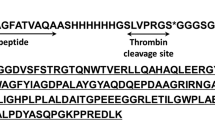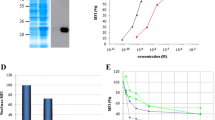Abstract
We have fused the epidermal growth factor (EGF) to the amino terminus of Pseudomonas exotoxin A (PE) to create a cytotoxic agent, designated EGF-PE, which preferentially kills EGF-receptor-bearing cells. In this study, we analyzed the effect of the Ia domain, the binding domain, of PE on the cytotoxicity of EGF-PE towards EGF-receptor-bearing cells and tried to develop a more potent EGF-receptor-targeting toxin. EGF-PE molecules with sequential deletions at the amino terminus of PE were constructed and expressed in E. coli strain BL21 (DE3). The cytotoxicity of these chimeric toxins was then examined. Our results show that the amino-terminal and carboxy-terminal regions of the Ia domain of PE are important for the cytotoxicity of a PE-based targeting toxin. To design a more potent PE-based EGF-receptor-targeting toxin, a chimeric toxin, named EGF-PE(Δ34–220), which had most of the Ia domain deleted but retained amino acid residues 1–33 and 221–252 of this domain, was constructed. EGF-PE(Δ34–220) has EGF-receptor-binding activity but does not show PE-receptor-binding activity and is mildly cytotoxic to EGF-receptor-deficient NR6 cells. As expected, EGF-PE(Δ34–220) is a more potent cytotoxic agent towards EGF-receptor-bearing cells than EGF-PE(Δ1–252), where the entire Ia domain of PE was deleted. In addition, EGF-PE(Δ34–220) was shown to be extremely cytotoxic to EGF-receptor-bearing cancer cells, such as A431, CE81T/VGH, and KB-3-1 cells. We also found that EGF-PE(Δ34–220) was highly expressed in BL21 (DE3) and could be easily purified by urea extraction. Thus, EGF-PE(Δ34–220) can be a useful cytotoxic agent towards EGF-receptor-bearing cells.
Similar content being viewed by others
References
Allured VS, Collier RJ, Carroll SF, Mckay DB (1986) Structure of exotoxin A of Pseudomonas aeruginosa at 3.0-Angström resolution. Proc Natl Acad Sci USA 83:1320–1324
Banroques J, Abelson JN (1989) PRP4: a protein of the yeast U4/U6 small nuclear ribonucleoprotein particle. Mol Cell Biol 9:3710–3719
Bjorge JD, Chan TO, Antczak M, Kung HJ, Fujita D (1990) Activated type 1 phosphatidylinositol kinase is associated with the epidermal growth factor (EGF) receptor following EGF stimulation. Proc Natl Acad Sci USA 87:3816–3820
Chen SC, Chou CK, Wong FH, Chang C, Hu C (1991) Overexpression of epidermal growth factor and insulin-like growth factor-I receptors and autocrine stimulation in human esophageal carcinoma cells. Cancer Res 51:1898–1903
Eidels L, Proia RL, Hart DA (1983) Membrane receptors for bacteria toxin. Microbiol Rev 47:596–620
Hwang J, Chen MS (1989) Structure and function relationship of Pseudomonas exotoxin A: an immunochemical study. J Biol Chem 264:2379–2384
Hwang J, Fitzgerald DJ, Adhya S, Pastan I (1987) Functional domains of Pseudomonas exotoxin identified by deletion analysis of the gene expressed in E. coli. Cell 48:129–136
Lee CH, Lee EC, Tsai ST, Kung HJ, Liu YC, Hwang J (1993) An EGF-Pseudomonas exotoxin A recombinant protein with a deletion in toxin binding domain specifically kill EGF receptor bearing cells. Protein Eng 6:433–440
Liao CW, Chen H, Lee CH, Hseu TH, Hwang J (1994) Target specific killing of transformed cells by Pseudomonas exotoxin A-epidermal growth factor fusogen: a lipid bilayer binding domain located at the N terminus of the exotoxin moiety is essential for cytotoxicity. Biomedical J (in press)
Liu PV (1966) The roles of various fractions of Pseudomonas aeruginosa in its pathogenesis. III. Identify of the lethal toxins produced in vitro and in vivo. J Infect Dis 116:481–489
Middlebrook JL, Dorland RB (1984) Bacterial toxins: cellular mechanism of action. Microbiol Rev 48:199–221
Pastan I Fitzgerald D (1989) Pseudomonas exotoxin: chimeric toxins. J Biol Chem 264:15 157–15 160
Pastan I, Fitzgerald D (1991) Recombinant toxins for cancer treatment. Science 254:1173–1177
Pastan I, Willingham MC, Fitzgerald DJ (1986) Immunotoxins. Cell 47:641–648
Schneider CA, Lim RW, Terwilliger E, Herschman HR (1986) Epidermal growth factor-nonresponsive 3T3 variants do not contain epidermal growth factor receptor-related antigen or mRNA. Proc Natl Acad Sci USA 83:333–336
Shiah HS, Chen TY, Chang CM, Chow JT, Kung HJ, Hwang J (1992) Pseudomonas exotoxin A-epidermal growth factor (EGF) mutant chimeric protein as an indicator for identifying amino acid residues important in EGF-receptor interaction. J Biol Chem 33:24 034–24 040
Siegall CB, Chaudhary VK, Fitzgerald DJ, Pastan I (1989) Functional analysis of domain II, Ib and III of Pseudomonas exotoxin. J Biol Chem 264:14 256–14 262
Siegall CB, Nordan RP, Fitzgerald DJ, Pastan I (1990) Cell-specific toxicity of a chimeric protein composed of interleukin-6 and Pseudomonas exotoxin (IL6-PE40) on tumor cells. Mol Cell Biol 10:2443–2447
Studier FW, Moffatt BA (1986) Use of bacteriophage T7 RNA polymerase to direct selective high-level expression of cloned gene. J Mol Biol 189:113–130
Theur CP, FitzGerald D, Pastan I (1992) A recombinant form of Pseudomonas exotoxin directed at the epidermal growth factor receptor that is cytotoxic without requiring proteolytic processing. J Biol Chem 267:16 872–16 877
Xu Y, Richert N, Ito S, Merlino GT, Pastan I (1986) Characterization of epidermal growth factor receptor gene expression in malignant and normal human cell lines. Proc Natl Acad Sci USA 81:7308–7312
Author information
Authors and Affiliations
Rights and permissions
About this article
Cite this article
Liao, C.W., Hseu, T.H. & Hwang, J. A target-specific chimeric toxin composed of epidermal growth factor and Pseudomonas exotoxin A with a deletion in its toxin-binding domain. Appl Microbiol Biotechnol 43, 498–507 (1995). https://doi.org/10.1007/BF00218456
Received:
Revised:
Accepted:
Issue Date:
DOI: https://doi.org/10.1007/BF00218456




